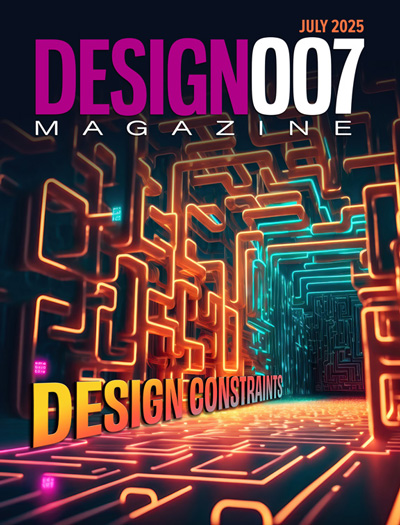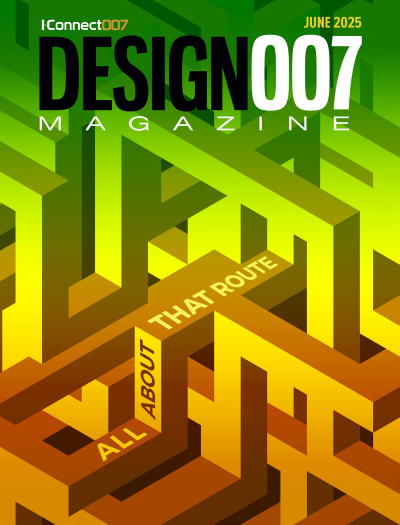-

- News
- Books
Featured Books
- design007 Magazine
Latest Issues
Current Issue
Proper Floor Planning
Floor planning decisions can make or break performance, manufacturability, and timelines. This month’s contributors weigh in with their best practices for proper floor planning and specific strategies to get it right.

Showing Some Constraint
A strong design constraint strategy carefully balances a wide range of electrical and manufacturing trade-offs. This month, we explore the key requirements, common challenges, and best practices behind building an effective constraint strategy.

All About That Route
Most designers favor manual routing, but today's interactive autorouters may be changing designers' minds by allowing users more direct control. In this issue, our expert contributors discuss a variety of manual and autorouting strategies.
- Articles
- Columns
- Links
- Media kit
||| MENU - design007 Magazine
Happy Holden and Charles Pfeil Discuss the Past and Future of PCB Design, Part 1
November 7, 2017 | Barry Matties, I-Connect007Estimated reading time: 10 minutes
When it comes to the PCB design community and the challenges facing it, as well as where design has been and where it’s heading, there aren’t many people as qualified to speak on the topic as long-time industry veterans Happy Holden and Charles Pfeil. I joined Happy and Charles at the recent AltiumLive 2017 event in San Diego for a discussion about the current state of PCB design, what the future holds, and what it means to be a designer.
BARRY MATTIES: You both have been in the industry for a number of years. Tell me about how you got your start. Charles, let’s begin with you.
CHARLES PFEIL: I started working summers when I was in high school, so 1966. My first job was doing QA on Rubylith designs for Northrop. Then I eventually became a designer and I job-shopped for probably about 14 years before I started my own service firm.
MATTIES: So it was always design then?
PFEIL: Always design, yeah.
MATTIES: When did you two meet?
HAPPY HOLDEN: Mentor?
PFEIL: No, before Mentor. We probably met at trade shows prior to Mentor. I'm sure of that.
MATTIES: There's a lot of history between the two of you.
HOLDEN: Lost in antiquity. You should've asked us 10 years ago. We would've remembered (laughs).
PFEIL: I was writing my book around 2005, so I know we met before that.
MATTIES: In any case, you started out with circuit design. That was how many years ago?
PFEIL: It was 51 years ago.
MATTIES: What's the most dramatic change that you've seen in circuit board design?
PFEIL: I think it's the impact of miniaturization, the impact of high-speed circuits, and the impact of new fabrication technologies. One of the difficulties has always been keeping up with that, especially with software design. When developing software, we'll start working on something to support a new technology and then, before you know it, it's moved on to some other technology before that method has matured. That's why so often the software companies are behind the curve when it comes to keeping up with technology and fabrication changes.
MATTIES: When you say the impact of miniaturization, what sort of impact do you mean?
PFEIL: The type of design solutions that used to be valid became invalid. A great example was when grids were no longer a valid method for primary routing. When they switched over to surface mount and you had to go between the pins and you're not on a grid, I was working at ASI at that time. We had to make significant enhancements to support that technology. All the algorithms were based on a grid, so you could have a rather rough minimum resolution. But as soon as you go gridless, you've got to have a very fine resolution, which means all the algorithms would no longer work effectively. So that was a big change.
MATTIES: What do you think the greatest challenge is today in PCB design?
PFEIL: I think understanding high-speed circuits and designing them in a way that they'll behave as desired.
MATTIES: I was just listening to Max Seeley, the gentleman from 3M. He's one of the keynotes here. He said it's really the EEs that are going to become circuit designers.
PFEIL: I think Happy would agree with me that the designers who have experience with manual design are retiring or passing away. The good news is that most of the ones coming up behind them have electronics education. They know circuit design. They choose to do PCB design, like Rick Hartley, a great example. For them, the design is really a big challenge, but because they understand the circuit side better, I think it's easier for them.
MATTIES: The tool certainly makes it easier.
PFEIL: But for a circuit engineer to go into design and not understand the fabrication process and or how to constrain it properly and not over-constrain it, that's a challenge.
MATTIES: One of the things that we often hear, and you just mentioned it, is designers not understanding the manufacturing process. I hear that frequently. Is it really their job to understand the manufacturing process, or is their job to get feedback from the manufacturing process?
HOLDEN: I for a long time have advocated that it's useful for designer to get a tour of a PC board shop and sit down with the fabricators. But for a designer magically to understand the nuances of what takes a process engineer an entire career to learn, they're not going to learn in one hour. You're deluding yourself if you think you're going to give these designers this two-hour tour of how PC boards are made and they're never going to make a mistake again.
Page 1 of 2
Testimonial
"In a year when every marketing dollar mattered, I chose to keep I-Connect007 in our 2025 plan. Their commitment to high-quality, insightful content aligns with Koh Young’s values and helps readers navigate a changing industry. "
Brent Fischthal - Koh YoungSuggested Items
VVDN Expands Manufacturing Footprint into the UAE to Meet Global Demand
08/20/2025 | PRNewswireVVDN Technologies, a global provider of software, product engineering and electronics manufacturing services & solutions, today announced it is setting up a new manufacturing facility in the UAE as part of its global expansion strategy.
Haylo Labs Acquires Plessey Semiconductors
08/20/2025 | Haylo LabsHaylo Labs has acquired Plessey Semiconductors, the UK’s leading innovator in microLED display technology.
Kimball Electronics Veterans ERG Members Proudly Participate in the 5th Annual Honor and Remember Run
08/20/2025 | Kimball ElectronicsVeterans and Military Service Advocacy (VMSA) Employee Resource Group (ERG) members Michael Mosher (Database Administration Engineer), Michael Stone (Test Technician Team Lead), and Joshua Belcher (Application Development Manager) took part in the 5th Annual Honor & Remember Run, a meaningful event dedicated to honoring fallen service members. The race featured a powerful memorial wall constructed from dog tags.
Meet Incap UK at the Electronic Component Show 2025
08/20/2025 | IncapIncap UK is pleased to be exhibiting at the Electronic Component Show 2025. This one-day event will take place on 18 September at the Kassam Stadium in Oxford, bringing together design engineers, purchasing professionals, manufacturers, distributors, and service providers to discover new products, solutions, and contacts. You will find us at stand 52.
Hon Hai Rotating CEO Yang Qiujin Wins 2025 Golden Yang Award for Women’s Power in Technology
08/20/2025 | Hon Hai Precision Industry Co., Ltd.Amid the global rise of "female-powered technology," Yang Qiujin, Rotating CEO of Hon Hai Precision Industry Co., Ltd. (TWSE: 2317), the world's largest platform solutions provider, has been awarded the "2025 Golden Yang Award - Female-Powered Technology" by the China Software Association/China Software Industry Association.


